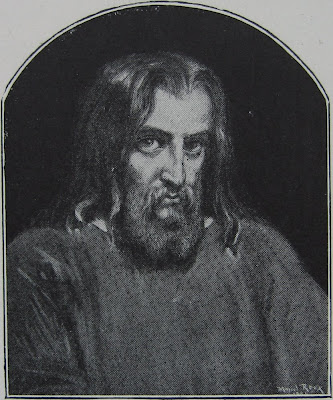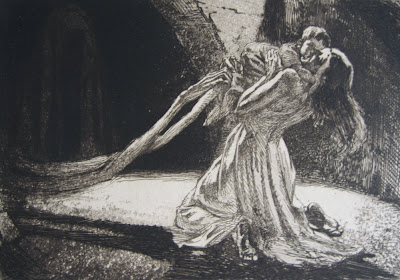
Marcel Roux, Self-portrait
The anguish expressed in the art of Marcel Roux - a complex blend of asceticism and decadence - makes him a unique and haunting figure. Roux was born in Bessenay (Rhône), where there is now a Musée Marcel Roux celebrating his art. After studying at the Beaux-Arts in Lyon, he became a pupil of Paul Borel. Both men shared a passionate, almost unhealthily fervent Catholicism. In Marcel Roux this devout faith is so feverish in its intensity it resembles no artists more than the princes of darkness, Félicien Rops and Charles Baudelaire. In her essay on Roux in Les Nouvelles de l'Estampe (mai-juin 1989, no. 105), Colette E. Bidon quotes the Lyonnais historian Mathieu Varille's verdict on his work: "diabolique et apocalyptique", diabolical and apocalyptic.

Marcel Roux, L'enfant et la Mort
Original etching, 1905
This etching was first issued as plate 11 of the suite Danse macabre, in an edition of 50 signed copies. In 1925 it was reprinted from the copper plate by the Revue de l'Art ancien et moderne, to accompany an essay on Roux by Justin Godart. Most copies were on wove paper. This is one of about 20 special copies printed on Japan paper, specially printed for M. le Vicomte G. de Fontarce.
Marcel Roux was inspired to specialise in etching after seeing the etchings of Rembrandt. Rembrandt's mastery of light and shade can be seen in Marcel Roux's etchings, but they also have the phantasmagorical passion of Goya. Essentially a visionary, working within a Symbolist aesthetic, Marcel Roux was haunted by the idea of death and hell, and tormented by a sense of social injustice and human suffering. As a result, religious and social themes intertwine in his work in a mysterious and powerful way. The Cabinet des Estampes of the Bibliothèque Nationale has an etching from his 1905 suite Danse Macabre, to which the etching "L'Enfant et la Mort" belongs. This suite is regarded by the art historian Colette E. Bidon, the authority on the art of Marcel Roux, as his masterwork.

Marcel Roux, Celui qui vit en moi
Original etching with aquatint, 1908
Copy 67/300, one of 250 on Hollande Van Gelder laid paper; the first 50 copies were on Japan.
Three years later, Roux made another powerful series of dark, brooding etchings on the themes of suffering, death, and resurrection, inspired by a now-forgotten poem on the story of Lazarus, Lazare le Ressuscité, written by Louis Mercier.

Marcel Roux, La mort s'approche
Original etching with aquatint, 1908
Copy 67/300, one of 250 on Hollande Van Gelder laid paper; the first 50 copies were on Japan.
Marcel Roux's health never recovered from his experiences as a medical orderly in WWI, and he died prematurely at the age of only 44. After the war his health was too poor for etching, and he turned instead to wood engraving, planning, but not having time to execute, a series of plates Contre la guerre. Following his death in 1922, Justin Godart organised a retrospective of his work at the Salon d'Automne de Lyon, at which 117 works were displayed, including all 15 of the series Danse Macabre.

Marcel Roux, Des mains rapaces
Original etching with aquatint, 1908
Copy 67/300, one of 250 on Hollande Van Gelder laid paper; the first 50 copies were on Japan.
For more information, visit the splendid website of the Musée Marcel Roux, which is at http://ampaen.mumaro.free.fr/index.html
Oh, you've just made my day (week)! I really have never heard of Roux, and his work is amazing...!
ReplyDeleteThanks! I thought you might be interested... It's really strange to find an artist so extremely religious he meets up with Rops and Baudelaire in the middle. Actually Marcel Roux illustrated Les Fleurs du Mal. I haven't seen it, and there's just one original woodcut, but the one drawing on the museum site is as decadent as it gets - a naked crouching woman with snakes suckling at her nipples. The museum website really is worth a look - they have pretty well everything ever written about Roux, and a lot of images. He seems to have been a hyper-sensitive person with a naturally morbid personality (a third of his etchings include Death either literally or figuratively) and the horrors of the First World War just wrecked his physical and mental health. When I opened the issue of the Revue de l'Art ancien et moderne with the etching L'enfant et la Mort, I just sensed immediately I was in the presence of a great artist. I'd never heard of him either. I'm very grateful to Marc Chazaud for steering me towards the museum site.
ReplyDeleteThat combination of extreme religiosity and dark eroticism must make emotional sense to the artists who express it. Thank you for pointing out the museum website.
ReplyDelete